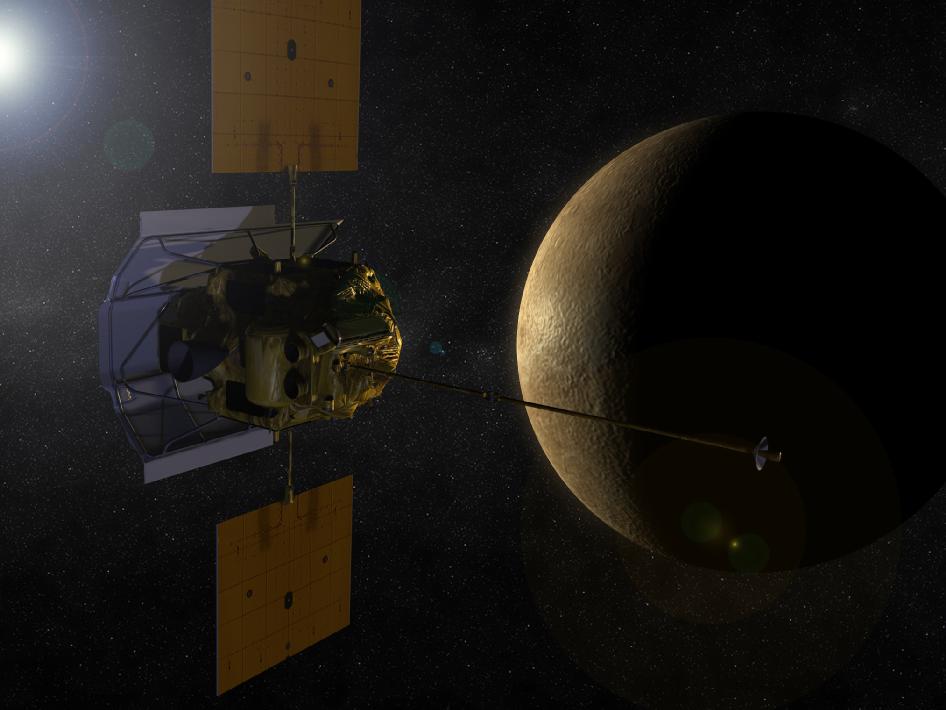The orbit insertion maneuver will place the spacecraft in an orbit that will last 12 hours when the closest point in front of the planet will be at an altitude of 200 kilometers. At the time of insertion into orbit, Messenger will be 46.15 million kilometers from the Sun and approximately 155 million kilometers from Earth.

After more than a dozen skips in the inner solar system, NASA's Messenger spacecraft will enter orbit around the planet Mercury tonight. The delicate spacecraft - carrying seven scientific instruments and shielded against the harsh environment near the Sun will be the first spacecraft to orbit the innermost planet.
At 20:45 EST - 02:45 Israel time (the difference is currently six hours because in the US they have already switched to daylight saving time), Messenger will turn her big engine close to her direction of travel and then it will be activated for 14 seconds while the other engines will be activated for a minute Additionally, this will slow its speed by 862 meters per minute and consume 31 percent of the fuel it carried during launch. Less than 9.5% of the fuel it carried at the start of the mission will remain after the orbit insertion maneuver is completed, but the spacecraft will have enough fuel left for future orbit corrections.
The orbit insertion maneuver will place the spacecraft in an orbit that will last 12 hours when the closest point in front of the planet will be at an altitude of 200 kilometers. At the time of insertion into orbit, Messenger will be 46.15 million kilometers from the Sun and approximately 155 million kilometers from Earth.
Messenger has so far spent six years in space and became the first spacecraft to orbit a hot star. The spacecraft follows an orbit in the inner solar system during which it approached Earth once, Venus twice and passed by Mercury three times. This impressive mission yielded the first data on the planet Hema since the Mariner 10 mission 30 years ago.
As of March 7, all three antennas of the Deep Space Network began continuous tracking, allowing flight controllers and engineers at Johns Hopkins University to make adjustments in preparation for entering orbit. The spacecraft also began to carry out the last flight command sequence in its mission when at the end the engines were ignited in preparation for the launch.
"This was a milestone for the small but experienced operations team, and caps six and a half years of successfully piloting the spacecraft through six planetary transits, five ignitions, and 16 speed and heading correction maneuvers, all simultaneously prepared to bring the spacecraft into orbit for its primary science mission. ” said Messenger system engineer Eric Finnigan.
"The cruise phase of MESSENGER has come to an end" added the principal investigator of the mission, Sean Solomon from the Carnegie Institution in Washington. "The insertion into orbit is the last obstacle before the next step - the operation of the first spacecraft around the planet Hema. The Messenger team is ready and ready to start work on the track."

8 תגובות
thank you for the answer!
Messenger's two main purposes are:
1) Learn about the magnetic field of Mercury
2) Check if there is ice in the craters at the poles of Mercury
I am interested to know what kind of observations will be made by the satellite and what is the purpose of the project?
Rami, there are several people I would gladly send to live there
Stunning
Actually, bending a spoon is more amazing, of course, they devoted several episodes on Israeli television to some great man who was perceived in the world for his absolutely impressive greatness, after years of reaching and thinking he managed to reach a human achievement that no one had reached before him, he managed to bend a spoon.
When will it be possible to live there on this planet?
It's been a long time since Yad Adam visited there.
Amazing and exciting. There is something to look forward to.